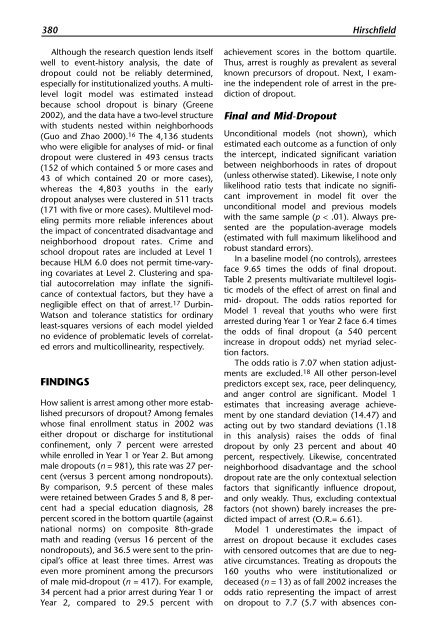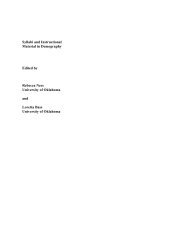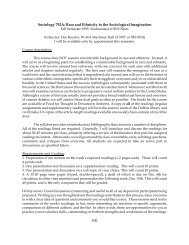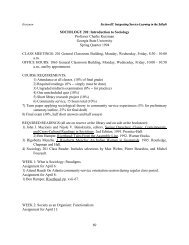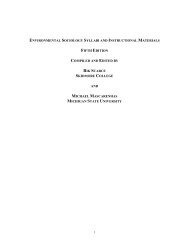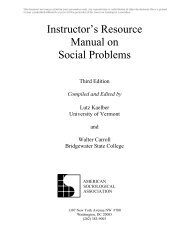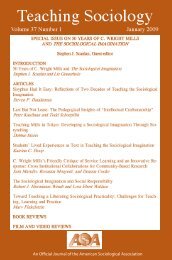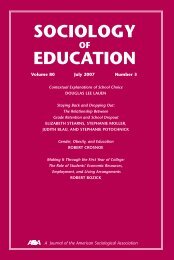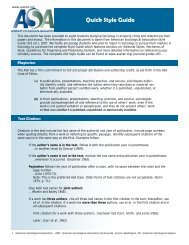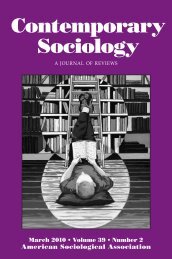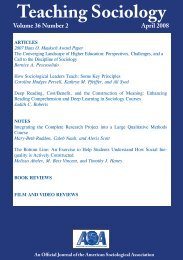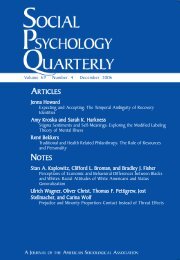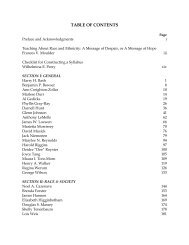SOCIOLOGY EDUCATION - American Sociological Association
SOCIOLOGY EDUCATION - American Sociological Association
SOCIOLOGY EDUCATION - American Sociological Association
Create successful ePaper yourself
Turn your PDF publications into a flip-book with our unique Google optimized e-Paper software.
380 Hirschfield<br />
Although the research question lends itself<br />
well to event-history analysis, the date of<br />
dropout could not be reliably determined,<br />
especially for institutionalized youths. A multilevel<br />
logit model was estimated instead<br />
because school dropout is binary (Greene<br />
2002), and the data have a two-level structure<br />
with students nested within neighborhoods<br />
(Guo and Zhao 2000). 16 The 4,136 students<br />
who were eligible for analyses of mid- or final<br />
dropout were clustered in 493 census tracts<br />
(152 of which contained 5 or more cases and<br />
43 of which contained 20 or more cases),<br />
whereas the 4,803 youths in the early<br />
dropout analyses were clustered in 511 tracts<br />
(171 with five or more cases). Multilevel modeling<br />
permits more reliable inferences about<br />
the impact of concentrated disadvantage and<br />
neighborhood dropout rates. Crime and<br />
school dropout rates are included at Level 1<br />
because HLM 6.0 does not permit time-varying<br />
covariates at Level 2. Clustering and spatial<br />
autocorrelation may inflate the significance<br />
of contextual factors, but they have a<br />
negligible effect on that of arrest. 17 Durbin-<br />
Watson and tolerance statistics for ordinary<br />
least-squares versions of each model yielded<br />
no evidence of problematic levels of correlated<br />
errors and multicollinearity, respectively.<br />
FINDINGS<br />
How salient is arrest among other more established<br />
precursors of dropout? Among females<br />
whose final enrollment status in 2002 was<br />
either dropout or discharge for institutional<br />
confinement, only 7 percent were arrested<br />
while enrolled in Year 1 or Year 2. But among<br />
male dropouts (n = 981), this rate was 27 percent<br />
(versus 3 percent among nondropouts).<br />
By comparison, 9.5 percent of these males<br />
were retained between Grades 5 and 8, 8 percent<br />
had a special education diagnosis, 28<br />
percent scored in the bottom quartile (against<br />
national norms) on composite 8th-grade<br />
math and reading (versus 16 percent of the<br />
nondropouts), and 36.5 were sent to the principal’s<br />
office at least three times. Arrest was<br />
even more prominent among the precursors<br />
of male mid-dropout (n = 417). For example,<br />
34 percent had a prior arrest during Year 1 or<br />
Year 2, compared to 29.5 percent with<br />
achievement scores in the bottom quartile.<br />
Thus, arrest is roughly as prevalent as several<br />
known precursors of dropout. Next, I examine<br />
the independent role of arrest in the prediction<br />
of dropout.<br />
Final and Mid-Dropout<br />
Unconditional models (not shown), which<br />
estimated each outcome as a function of only<br />
the intercept, indicated significant variation<br />
between neighborhoods in rates of dropout<br />
(unless otherwise stated). Likewise, I note only<br />
likelihood ratio tests that indicate no significant<br />
improvement in model fit over the<br />
unconditional model and previous models<br />
with the same sample (p < .01). Always presented<br />
are the population-average models<br />
(estimated with full maximum likelihood and<br />
robust standard errors).<br />
In a baseline model (no controls), arrestees<br />
face 9.65 times the odds of final dropout.<br />
Table 2 presents multivariate multilevel logistic<br />
models of the effect of arrest on final and<br />
mid- dropout. The odds ratios reported for<br />
Model 1 reveal that youths who were first<br />
arrested during Year 1 or Year 2 face 6.4 times<br />
the odds of final dropout (a 540 percent<br />
increase in dropout odds) net myriad selection<br />
factors.<br />
The odds ratio is 7.07 when station adjustments<br />
are excluded. 18 All other person-level<br />
predictors except sex, race, peer delinquency,<br />
and anger control are significant. Model 1<br />
estimates that increasing average achievement<br />
by one standard deviation (14.47) and<br />
acting out by two standard deviations (1.18<br />
in this analysis) raises the odds of final<br />
dropout by only 23 percent and about 40<br />
percent, respectively. Likewise, concentrated<br />
neighborhood disadvantage and the school<br />
dropout rate are the only contextual selection<br />
factors that significantly influence dropout,<br />
and only weakly. Thus, excluding contextual<br />
factors (not shown) barely increases the predicted<br />
impact of arrest (O.R.= 6.61).<br />
Model 1 underestimates the impact of<br />
arrest on dropout because it excludes cases<br />
with censored outcomes that are due to negative<br />
circumstances. Treating as dropouts the<br />
160 youths who were institutionalized or<br />
deceased (n = 13) as of fall 2002 increases the<br />
odds ratio representing the impact of arrest<br />
on dropout to 7.7 (5.7 with absences con-


